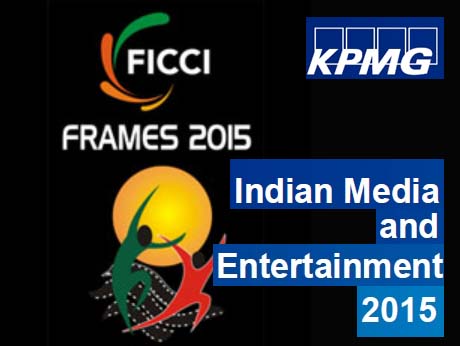
MUMBAI, March 26, 2015. Digital advertising in India has shown stupendous 44.5 per cent growth in 2014 over 2013. One of the major highlights in 2014 was the announcement of ‘Digital India –the programme to transform India into a digital economy, announced by the new Government at the Centre. India topped as the world’s fastest growing smartphone market. By the end of 2014, India had around 116 million internet enabled smartphones and the number is expected to reach 435 million by the year 2019.
These are some key findings of the the FICCI-KPMG Indian Media and Entertainment Industry Report 2015, titled ‘Shooting for the Stars’, released here yesterday, at the inaugural session of FICCI FRAMES 2015 media and entertainment conference.
The report notes that India’s significant consumer market base, and increasingly favourable macro-economic and regulatory environment have prompted several investors and global players to look to the Indian market for growth.Their optimism stems from the fact that the building blocks for future growth have been put in place in 2014 – such as new spectrum for mobile, ongoing digitization in cable, consolidation in exhibition, and Phase III auctions for radio. With the advertising boost from the ICC cricket world cup, strong projections for economic growth and on the base of these building blocks, 2015 holds great promise for the industry
The absolute number of internet connections was at a record high in 2014. With almost 9 per cent penetration of social media, India’s potential for social networking on the internet is on the rise. 41 per cent of India’s total mobile users are active on social media. The digital music industry witnessed a good deal of buyouts, sell-outs and new entries jockeying for position. The revenue from distribution of music through digital channels already accounts for over 50 per cent of the overall size of the music industry in India.
In television, advertising saw strong growth, driven by the general uplift in the macroeconomic environment, the general election spends, and the emergence of e-commerce as a significant new advertising spender. At the same time, despite rollout of digital set top boxes STBs as a part of the ongoing DAS, the anticipated improvement in addressability, increase in subscription revenues and more equitable sharing of subscription revenues continues to evade the industry.
The print sector continues to remain a highly fragmented space, at the national and regional level. In 2014, the print industry witnessed a rise in circulation revenues on the back of rising cover prices and subscriptions, aided by low media penetration, population growth and rising income and literacy levels. This growth largely came from tier II and tier III cities with regional language editions outperforming the national editions and English dailies.
The films sector was a mixed bag in 2014 with some films creating box office records, while several were unable to attract audiences to the theatre and profitability was impacted overall. The exhibition sector saw several players expanding their footprint – both organically (especially in tier II and tier III cities) and through acquisitions. The cable and satellite market also saw correction. Regional films continued to see success, in particular the Tamil and Telugu markets. Going forward, with an increasing number of multiplex screens and better internet penetration and bandwidth Tier 2 and Tier 3 cities may soon hold the prime focus of the industry.
The radio sector saw much awaited movement in Phase III auctions, with the Government giving the go ahead for partial auctions across 69 cities, potentially 135 channels. Though some key contentious issues of exorbitant reserve prices for the auctions, the 15% limit on the total number of frequencies that an entity may hold, as well as dearth of new frequencies in the profitable A and A+ cities remain, the commencement on Phase III provided the required fillip to the industry which hopes to revive its fortune with these new developments.
PDF of KPMG release here